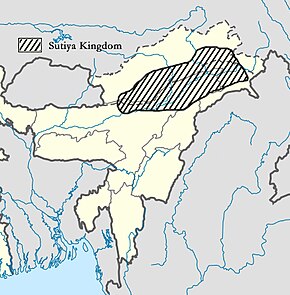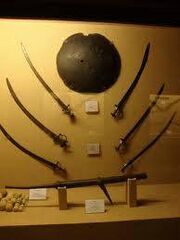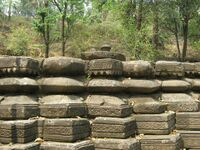History:Chutiya Kingdom
Chutiya Kingdom | |||||||||
|---|---|---|---|---|---|---|---|---|---|
| 1187–1673 | |||||||||
 The Chutiya Kingdom c. 13th century during the reign of King Gaurinarayan. | |||||||||
| Capital |
| ||||||||
| Common languages | Assamese, formerly Chutiya language | ||||||||
| Religion | Hinduism, Shaktism[1] | ||||||||
| Government | Monarchy | ||||||||
| Monarch | |||||||||
• 1187–1210 | Birpal (first) | ||||||||
• 1522–1524 | Nityapal (last) | ||||||||
| Historical era | Medieval Assam | ||||||||
• Founded by Birpal | 1187 | ||||||||
• Expansion under Gaurinarayan | 1210 -1250 | ||||||||
• Ahom-Chutiya war | 1513 -17th century | ||||||||
• Siege of Sadiya | 17 April 1524 | ||||||||
• Disestablished | 1673 | ||||||||
| |||||||||
| Today part of | India | ||||||||
The Chutiya Kingdom, (pronounced Sutia) (চুতীয়া in Assamese) (1187-1673), also known as Chutia, Sutiya or Sadiya, was a state established by one of the Chutiya chieftains named Birpal in 1187 CE in the areas comprising the present-day Indian states of Assam and Arunachal Pradesh. Birpal was one of the numerous Chutiya chieftains/rajas (who ruled Upper Assam and Arunachal) and initially ruled parts of present-day Arunachal Pradesh. Over the years he and his successors united all the hill and plain Chutiya kings of Assam as well as Arunachal Pradesh to form the greater Chutiya kingdom after the fall of Pala dominance. It was the largest kingdom in Assam after the fall of Kamrupa and before the rise of Ahom kingdom. The kingdom absorbed the ancient Pala dynasty of Kamarupa and reigned for over 400 years in eastern Assam and Arunachal Pradesh with its capital at Sadiya and Ratnapur.[2] It became the dominant power in eastern Assam in the 12th century and remained so until the 16th century with its domain from Parshuram Kund in the east to Vishwanath[3] in the west and in the process of its expansion had absorbed many local communities and tribes.
It controlled the present Assam districts of Lakhimpur, Dhemaji, Tinsukia, parts of Jorhat, Dibrugarh, Sonitpur and East Siang, Subansiri, Lower Dibang, Lohit districts of Arunachal Pradesh.[4]
Among the Chutiya kings was Gaurinarayan (Ratnadhwajpal), son of Birpal. He brought many other Chutiya groups into his kingdom. In 1224, Ratnadhwajpal defeated another Chutiya king named Bhadrasena, the king of Swetagiri, and conquered the area between Subansiri and Sissi rivers, i.e. present-day Dhemaji district. In 1228, he went on another campaign to further expand his kingdom and subjugate the Chutiya king Nyayapal (ruling the areas between Biswanath and Subansiri,i.e. present-day Biswanath and Lakhimpur districts) and marched toward Kamatapur, where he formed an alliance with the Kamata ruler by marrying a princess. Then he marched to Dhaka, and made friends with the Gauda ruler. The hostilities with the Ahoms began when the Chutiya Kingdom expanded to the south during which the Ahom king, Sutuphaa, was killed by the Chutiya king during a friendly negotiation. This conflict triggered a number of battles between the two sides which saw great loss of men and money. The simmering dispute often flared till 1524 when the Ahoms struck the Chutiya Kingdom at its weakest state, took Sadiya and killed the then king, Nityapal. The Ahoms established their rule by instituting the position of Sadiyakhowa Gohain, a newly constituted position of frontier-governor in charge of Sadiya. But the Chutiya had dispersed to frontier regions, and continued raids against the Ahoms. It finally ended in 1673 when they fell under the domination of the Ahoms.
History
Chutiya Bhuyan chieftains
Bhuyans were chiefs of North Indian settlers who migrated to Assam in two separate groups once during the Mleccha rule of 9th century and again during the Kamatapur rule in the 14th century. They were given land in central Assam by the Indigenous Mleccha and Kamatapur kings in order to promote sanskritisation in Assam. The first group were called the Bor Bhuyans. The Borbhuyans settled in the region west of the Chutiya kingdom i.e. parts of the present day districts of Darrang and Sonitpur. The Bhuyan status at that time was open to royals of any ethnicity and the rule was a confederation type, due to which many Chutiya chieftains of Sonitpur and Lakhimpur districts also adopted the title. These were known as the Chutiya Bhuyans who ruled as sovereign states until Gaurinarayan brought them under the greater Chutiya kingdom in the early 13th century.
Foundation
The founder of the medieval greater Chutiya kingdom was Birpal who claimed descent from the legendary Bhishmak and reigned in 1187. He ruled over 60 clans with his capital on a hill called Swarnagiri and assumed the title of Gayapal. He was succeeded by his son Sonagiri assuming the title of Gaurinarayan.[5]
Gaurinarayan alias Ratnadhwajpal was one of the most powerful Sutiya kings. He brought under his sway the tribes of neighbouring mountains; the Rangalgiri, the Kalgiri, the Nilgiri, the Chandragiri, and the Dhavalgiri. He conquered the whole northeastern region of Assam which included the areas of present-day Arunachal Pradesh and assumed the title "Lord of Hills". In the year 1224, with a large army, he descended on the valley of Brahmaputra, attackeing and deporting another Chutiya king, Bhadrasena, ruler of the Swetagiri. In the expedition he gained rich booty and many prisoners of war belonging to the Brahmin, Tanti, Sonari, Sutar and Kumar classes and settled them in various parts of the kingdom. He built his capital at Ratnapur (Majuli), hence also called Ratnadhwajpal and used certain techniques to advance the agricultural system in the kingdom. The neighbouring Chutiya king, Nyaya Pal surrendered with costly gifts even before he was attacked. To cement the alliance, he married the daughter of Nyayapal. He built a line of forts along the foot of the bills against inroads by the hill tribes and built large tanks and temples for his people. In Kamatapur, when Kamateswar refused his daughter for one of Gaurinarayan sons, the king marched against him, constructing a road with forts at certain intervals. Alarmed at the energy displayed by his troops, Kamateswar agreed to give one of the princesses in marriage to the Sutiya prince.[5]
These expeditions by Gaurinarayan took Chutiya Kingdom to supremacy to such an extent that after a few years the impact of his power was felt even by the Gauda ruler. The Gauda ruler, possibly Khesav Sen, made friends with Gaurinarayan who sent one of his sons to that country to be educated. Unfortunately, the Sutiya Prince died there and the corpse was sent to Gaurinarayan, who was then engaged in building a new city. He named the city as Sadiya (Sa-Corpse, Diya-Given) which later on became the capital of the Chutiya Kingdom. Extensive remains of buildings and fortifications built during the rule of the Sutiyas near about Sadiya still point to the importance of the region in the past.
During the reign of Ahom king Sutuphaa, there were frequent skirmishes between Ahoms and Sutiyas. In 1376, Sutuphaa was killed by the Sutiya King Jayadhwajpal during a friendly encounter. During following years, both sides were involved in numerous battles.
Ahom-Sutiya conflicts (1513-1522)
Dhirnarayan alias Dharmadhwajpal, engaged in many battles with the Ahoms. In 1513, in a battle with the Ahoms, king Dhirnarayan attacked the Ahom Kingdom both by land and water. The Ahom were victorious in the battle fought at Dikhoumukh. Later in 1520, the Sutiyas invaded Ahom territory twice; in the second invasion the Sutiyas killed the Ahom commander and were successful in defeating the Ahoms in the battle fought at Dihing.[6]
Downfall
The kingdom saw its weakest state under Nityapal, the husband of Dhirnarayan daughter Sadhani. In 1522, Dhirnarayan due to his growing age passed down his throne to Nityapal. The Sutiya nobilities and ministers resisted the decision of giving away the throne to Nityapal. In 1524, due to Nityapal incapable rulership, the Ahoms taking advantage of this chance, attacked a much weaker Chutiya Kingdom. As a partial culmination of the inter-kingdom feud, the Ahoms took Sadiya and killed Nityapal. Further to strengthen their position, the Ahoms set up colonies in the Sutiya country and a number of Brahmins, blacksmiths and artisans were deported from Sadiya to Charaideo.[6] However the Sutiyas went to the countryside where they were still in power and continued their fight against the Ahoms to reclaim their lost territories. The conflict went on for next 150 years until it finally ended in 1673 when the Sutiyas fell under the domination of the Ahoms and were absorbed into their state.[5]
Rulers (1187 - 1524)
| # | Years | Reign | Name | Other names |
|---|---|---|---|---|
| 1 | 1187 - 1210 | 23 y | Birpal | Gayapal |
| 2 | 1210 - 1250 | 40 y | Ratnadhwajpal | Gaurinarayan |
| 3 | 1250 - 1270 | 20 y | Vijayadhwajpal | Shivanarayan |
| 4 | 1270- 1285 | 15 y | Vikramadhwajpal | Jagatnarayan |
| 5 | 1285 - 1305 | 20 y | Gauradhwajpal | Pramonarayan |
| 6 | 1305 - 1325 | 20 y | Sankhadhwajpal | Harinarayan |
| 7 | 1325 - 1343 | 18 y | Mayuradhwajpal | Goluknarayan |
| 8 | 1343 - 1360 | 17 y | Jayadhwajpal | Bijonarayan |
| 9 | 1360 - 1380 | 20 y | Karmadhwajpal | Nandeshwar |
| 10 | 1380 - 1400 | 20 y | Satyanarayan | |
| 11 | 1400 - 1420 | 20 y | Laxminarayan | |
| 12 | 1420 - 1440 | 20 y | Dharmanarayan | |
| 13 | 1440- 1465 | 25 y | Pratyashnarayan | |
| 14 | 1465 - 1480 | 15 y | Yasnarayan | |
| 15 | 1480 - 1500 | 20 y | Purnadhabnarayan | |
| 16 | 1500- 1522 | 22 y | Dharmadhwajpal | Dhirnarayan |
| 17 | 1522 - 1524 | 2 y | Nityapal | Chandranarayan/Nitai |
Geography
The Sutiyas held the areas to the north of Brahmaputra from Parshuram Kund in the east to Vishwanath in the west which represents the areas of Dhemaji district, Lakhimpur district and Sonitpur district of present Assam. To the north, it controlled the present Miri Hills, Abor Hills and the Mishmi Hills (Rangalgiri, Kalgiri, Nilgiri, Chandragiri, Dhavalgiri)[1] in the state of Arunachal Pradesh. To the south of the Brahmaputra, it had parts of Dibrugarh district and almost the entire Tinsukia district under its rule.[4]
Monuments
The Chutiya rulers were involved in building forts, temples and palaces during their rule. However, most of these monuments have disappeared in the heart of the river Brahmaputra during the 1950 Assam–Tibet earthquake and the remaining are now in dilapidated state as no initiative has taken place to conserve them. One of the known monuments built by the Chutiyas was the Tamreswari temple in Sadiya.[5]
Ruins of an ancient town are found between the river Dhal and Ghagar to 8 km east of present town of North Lakhimpur. A Sutiya king built the town during the 14th and 15th century which was deserted or destroyed by natural calamity like earthquake or flood. Other momuments which flourished during the Sutiya reign is Bhismaknagar, located 25 km from Roing.[citation needed]
Malinithan temple near Likabali in North Lakhimpur, Ita Fort in Arunachal Pradesh and Garakhiathan located at Selajan Sonowal Kachari village are other prominent monuments build during the Sutiya rule.[citation needed]
Existing and known monuments:
- Gomsi
- Maghnowa Temple
References
Citations
- ↑ 1.0 1.1 Prakash 2007, pp. 911–916.
- ↑ Sadiya is an Assamese name for king of the Chutiyas. It was the name of the kingdom as well its capital
- ↑ Prakash 2007, pp. 913.
- ↑ 4.0 4.1 Gogoi 2006, pp. 20–21.
- ↑ 5.0 5.1 5.2 5.3 Prakash 2007, pp. 267.
- ↑ 6.0 6.1 Pathak 2008.
Bibliography
- Prakash, Col. Ved (2007), Encyclopedia of North East India, 2, Atlantic Publishers & Dist.
- Pathak, Guptajit (2008), Assam's history and its graphics, Mittal Publications
- Gogoi, Punyadhar (2006), War Weapons in Medieval Assam, Concept Publishing




